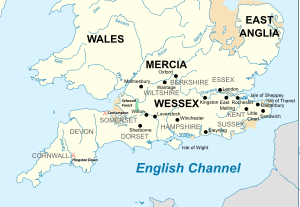Battle of Hingston Down facts for kids
Quick facts for kids Battle of Hingston Down |
|||||||
|---|---|---|---|---|---|---|---|
| Part of the Viking invasions of England | |||||||
|
|||||||
| Belligerents | |||||||
| Anglo-Saxons | Cornish Danish Vikings |
||||||
| Commanders and leaders | |||||||
| Egbert | Unknown | ||||||
| Casualties and losses | |||||||
| Unknown | Unknown | ||||||
The Battle of Hingston Down was an important fight that happened in the year 838. It probably took place at a spot called Hingston Down in Cornwall. This battle was fought between two main groups. On one side were the Cornish people, who lived in Cornwall, and their allies, the Vikings from Denmark. On the other side were the West Saxons, led by their powerful king, Ecgberht. The West Saxons won this battle.
We know about this battle from an old book called the Anglo-Saxon Chronicle. This book called the Cornish people "West Welsh." It says that a large group of Viking ships arrived and joined forces with the Cornish. Together, they decided to fight against King Ecgberht. When King Ecgberht heard about this, he quickly gathered his army. He marched to Hingston Down, where he fought them. The chronicle says he made both the Cornish and the Vikings run away.
Historians who study early medieval Britain usually agree that the battle happened at Hingston Down, which is north-east of Callington in Cornwall. However, some writers think it might have been at a different Hingston Down, located near Moretonhampstead in Devon.
Why the Battle Happened
For a long time, there was conflict between the kingdom of Dumnonia and the kingdom of Wessex. Dumnonia covered what is now Devon and Cornwall. Wessex, an Anglo-Saxon kingdom, slowly expanded its control westward. By the early 700s, Wessex had already taken over eastern Devon.
Fighting continued throughout the 700s. Wessex kept pushing further into Dumnonian lands. In 815, King Ecgberht of Wessex led a raid across Cornwall. He went "from east to West." This likely means he conquered the remaining parts of West Devon. This set the stage for later battles like the one at Hingston Down.
The End of a Long Conflict
The Battle of Hingston Down was the last major recorded battle between the Cornish people and the West Saxons. This battle brought an end to about a century of warfare between them. This long period of fighting had started with the Battle of Llongborth in 710.
After this battle, the Cornish kingdom became less independent. The last known king of Cornwall was Dungarth, who died in 875. He is believed to have been an "under-king." This means he ruled Cornwall, but he was still under the authority of the King of Wessex. The Battle of Hingston Down marked a significant moment in the history of Cornwall and the expansion of the Anglo-Saxon kingdom of Wessex.
Images for kids



